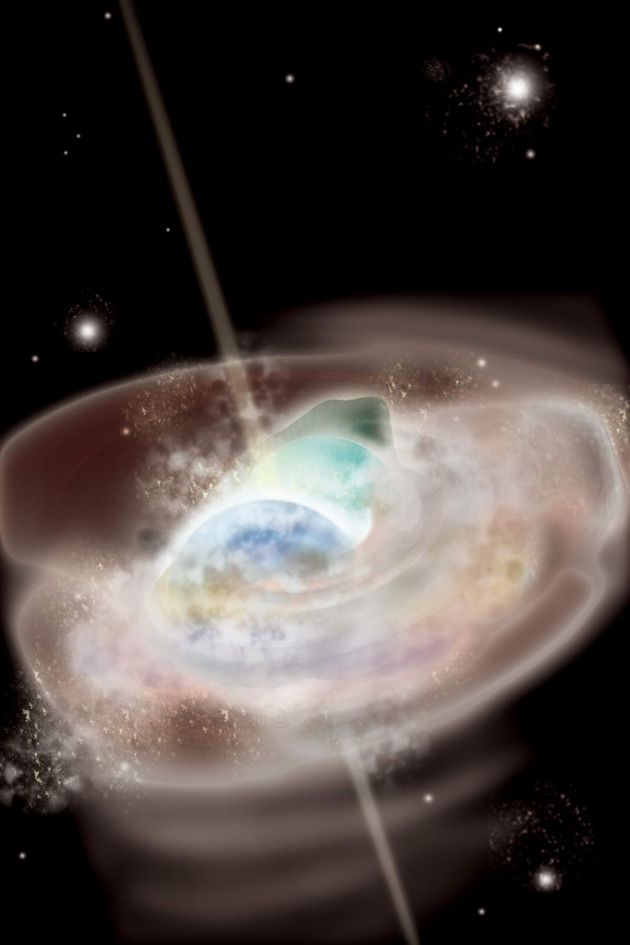Creation of Black Hole Detected

Astronomers photographed a cosmic event this morning which they believe is the birth of a black hole, SPACE.com has learned.
A faint visible-light flash moments after a high-energy gamma-ray burst likely heralds the merger of two dense neutron stars to create a relatively low-mass black hole, said Neil Gehrels of NASA's Goddard Space Flight Center. It is the first time an optical counterpart to a very short-duration gamma-ray burst has ever been detected.
Gamma rays are the most energetic form of radiation on the electromagnetic spectrum, which also includes X-rays, light and radio waves.
The merger occurred 2.2 billion light-years away, so it actually took place 2.2 billion years ago and the light just reached Earth this morning.
Quick global effort
Gehrels said the burst occurred just after midnight East Coast time. It was detected by NASA's orbiting Swift telescope. Swift automatically repositioned itself within 50 seconds to image the same patch of sky in X-rays. It just barely caught an X-ray afterglow, Gehrels said in a telephone interview.
The X-ray counterpart was barely detectable and only observed for a few minutes.
Breaking space news, the latest updates on rocket launches, skywatching events and more!
An email was sent out to astronomers worldwide, and large observatories then tracked to the location and spotted a faint visible-light afterglow.
Gamma ray bursts are mysterious beasts. They come from all over the universe. Long-duration bursts, lasting a few seconds, are thought to be associated with the formation of black holes when massive stars explode and collapse. In recent years, scientists have detected X-ray and optical afterglows of these long bursts.
Very short-duration bursts, like the one this morning, last only a tiny fraction a second. Until now, no optical afterglows from these bursts have been detected. Theorists think a burst like this represents the formation of a black hole a few times the mass of the Sun, but if so, then there should be flashes of X-rays and visible light, too.
The burst has been named GRB050509b.
What happened
Steinn Sigurdsson, a Penn State University researcher who is excited about the observations but was not involved in them, explained what theorists think happened:
Over a long time period, at least a hundred million years and perhaps billions of years, the two neutron stars spiraled toward each other. Neutron stars themselves are very dense objects, collapsed stellar remnants.
"A fraction of a second before contact, the lower mass neutron star is disrupted and forms a neutrino driven accretion disk around the higher mass neutron star," Sigurdsson told SPACE.com. "It implodes under the weight and forms a maximally spinning low-mass black hole."
Astronomers can't see black holes, because light and everything else that enters them is lost to observation. But just before material falls in, some high-energy process -- likely involving magnetism and speeds approach that of light -- vents some of the material back into space.
The gamma ray burst signals the formation of a superheated jet of gas being shot out from the chaotic region around the newly formed black hole at a significant fraction of light-speed, Sigurdsson said.
"This really does look like a merger scenario," said Gehrels, who heads up the scientific operations for the Swift satellite.
The first gamma-ray burst was detected by accident in 1967. It was found by U.S. satellites deployed to monitor possible violations of the nuclear test ban treaty. Researchers now know that one erupts roughly every day somewhere in the cosmos. Most originate many billions of light years away.
Each burst can briefly outshine an entire galaxy. Gamma-ray bursts in our own galaxy are very rare. Some scientists speculate that such bursts in the Milky Way's past might have caused mass extinctions on Earth.
- Brightest Galactic Flash Ever Detected Hits Earth
- Neutron Star Collisions Common, Study Suggests
- Closest Known Neutron Star Races Across Sky
- Gamma Rays Linked to Black Hole's Birth
- Birth of a Black Hole is Messy, New Observations Suggest

Rob has been producing internet content since the mid-1990s. He was a writer, editor and Director of Site Operations at Space.com starting in 1999. He served as Managing Editor of LiveScience since its launch in 2004. He then oversaw news operations for the Space.com's then-parent company TechMediaNetwork's growing suite of technology, science and business news sites. Prior to joining the company, Rob was an editor at The Star-Ledger in New Jersey. He has a journalism degree from Humboldt State University in California, is an author and also writes for Medium.
